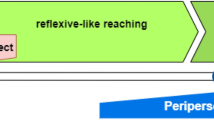Abstract
Recently, the aspect of visual perception has been explored in the context of Gibson’s concept of affordances [1] in various ways. We focus in this work on the importance of developmental learning and the perceptual cueing for an agent’s anticipation of opportunities for interaction, in extension to functional views on visual feature representations. The concept for the incremental learning of abstract from basic affordances is presented in relation to learning of complex affordance features. In addition, the work proposes that the originally defined representational concept for the perception of affordances - in terms of using either motion or 3D cues - should be generalized towards using arbitrary visual feature representations. We demonstrate the learning of causal relations between visual cues and associated anticipated interactions by reinforcement learning of predictive perceptual states. We pursue a recently presented framework for cueing and recognition of affordance-based visual entities that obviously plays an important role in robot control architectures, in analogy to human perception. We experimentally verify the concept within a real world robot scenario by learning predictive visual cues using reinforcement signals, proving that features were selected for their relevance in predicting opportunities for interaction.
Preview
Unable to display preview. Download preview PDF.
Similar content being viewed by others
References
Gibson, J.J.: The Ecological Approach to Visual Perception, Boston, Houghton Mifflin (1979)
Neisser, U.: Cognition and Reality. In: Principles and Implications of Cognitive Psychology, Freeman & Co., San Francisco (1976)
Gibson, E.J.: Exploratory behavior in the development of perceiving, acting and the acquiring of knowledge. Annual Review of Psychology 39, 1–41 (1988)
Faillenot, I., Toni, I., Decety, J., Grégoire, M.-C., Jeannerod, M.: Visual pathways for object-oriented action and object recognition: functional anatomy with PET. Cerebral Cortex 7, 77–85 (1997)
Fagg, A.H., Arbib, M.A.: Modeling parietal-premotor interaction inprimate control of grasping. Neural Networks 11(7-8), 1277–1303 (1998)
Wheeler, S.D., Fagg, H.A., Grupen, R.A.: Learning Prospective Pick and Place Behavior. In: Proc. 2nd International Conference on Development and Learning, June 2002, pp. 197–202. IEEE Computer Society, Cambridge, MA (2002)
Paul, F., Metta, G., Natale, L., Rao, S., Sandini, G.: Learning About Objects Through Action - Initial Steps Towards Artificial Cognition. In: ICRA 2003. Proc. IEEE International Conference on Robotics and Automation, Taipei, Taiwan (May 12-17, 2003)
Stoytchev, A.: Behavior-Grounded Representation of Tool Affordances. In: ICRA. Proc. IEEE International Conference on Robotics and Automation, April 18-22, 2005, Barcelona, Spain (2005)
Stark, L., Bowyer, K.W.: Function-based recognition for multiple object categories. Image Understanding 59(10), 1–21
Rivlin, E., Dickinson, S.J., Rosenfeld, A.: Recognition by functional parts. Computer Vision and Image Understanding 62, 64–176 (1995)
Bogoni, L., Bajcsy, R.: Interactive Recognition and Representation of Functionality. Computer Vision and Image Understanding 62(2), 194–214 (1995)
Edwards, M.G., Humphreys, G.W., Castiello, U.: Motor facilitation following action observation: a behavioural study in prehensile action. Brain Cognition 53, 495–502 (2003)
Lowe, D.: Distinctive image features from scale-invariant keypoints. International Journal of Computer Vision 60(2), 91–110 (2004)
Quinlan, J.R.: C4.5 Programs for Machine Learning. Morgan Kaufmann, San Mateo, CA (1993)
Cos-Aguilera, I., Cañamero, L., Hayes, G.M., Gillies, A.: Ecological integration of affordances and drives for behaviour selection. In: Bryson, J., et al. (eds.) Proc. Workshop on Modeling Natural Action Selection, pp. 225–228. AISB Press (2005)
Cos-Aguilera, I., Cañamero, L., Hayes, G.M.: Using a SOFM to learn Object Affordances. In: Cos-Aguilera, I. (ed.) WAF 2004. Proc. Workshop of Physical Agents, March 2004, Girona, Catalonia, Spain (2004)
Fritz, G., Paletta, L., Kumar, M., Dorffner, G., Breithaupt, R., Rome, E.: Visual Learning of Affordance based Cues. In: Nolfi, S., Baldassarre, G., Calabretta, R., Hallam, J.C.T., Marocco, D., Meyer, J.-A., Miglino, O., Parisi, D. (eds.) SAB 2006. LNCS (LNAI), vol. 4095, pp. 25–29. Springer, Heidelberg (2006)
Puterman, M.: Markov decision processes: Discrete stochastic dynamic programming. John Wiley & Sons, New York (1994)
Paletta, L., Fritz, G., Seifert, C.: Q-Learning of Sequential Attention for Visual Object Recognition from Informative Local Descriptors. In: ICML 2005. Proc. 22nd International Conference on Machine Learning, Bonn, Germany, August 7-11, 2005, pp. 649–656 (2005)
Draper, B.A.: Modeling Object Recognition as a Markov Decision Process. In: Proc. 13th International Conference on Pattern Recognition 4, 95
Watkins, C., Dayan, P.: Q-learning. Machine Learning 8, 279–292 (1992)
Irran, J., Kintzler, F., Pölz, P.: Grounding Affordances. In: Trappl, R. (ed.) Cybernetics and Systems. Austrian Society for Cybernetic Studies, Vienna (2006)
Ugur, E., Dogar, M.R., Cakmak, M., Sahin, E.: The learning and use of traversability affordance using range images on a mobile robot. In: ICRA 2007. Proc. Internat. Conference on Robotics and Automation, pp. 1721–1726 (2007)
Doherty, P., Merz, T., Rudol, P., Wzorek, M.: Tentative proposal for a formal theory of affordances. Technical Report MACS/4/2.1, Linköpings Universitet, IDA Group, Linköping, Sweden (August 2005)
Author information
Authors and Affiliations
Editor information
Rights and permissions
Copyright information
© 2007 Springer-Verlag Berlin Heidelberg
About this paper
Cite this paper
Paletta, L., Fritz, G., Kintzler, F., Irran, J., Dorffner, G. (2007). Perception and Developmental Learning of Affordances in Autonomous Robots. In: Hertzberg, J., Beetz, M., Englert, R. (eds) KI 2007: Advances in Artificial Intelligence. KI 2007. Lecture Notes in Computer Science(), vol 4667. Springer, Berlin, Heidelberg. https://doi.org/10.1007/978-3-540-74565-5_19
Download citation
DOI: https://doi.org/10.1007/978-3-540-74565-5_19
Publisher Name: Springer, Berlin, Heidelberg
Print ISBN: 978-3-540-74564-8
Online ISBN: 978-3-540-74565-5
eBook Packages: Computer ScienceComputer Science (R0)




